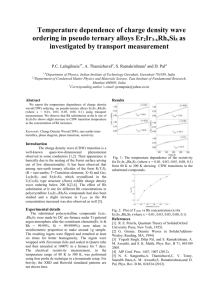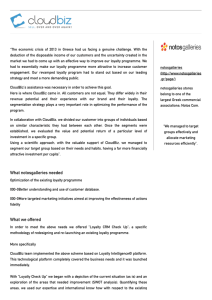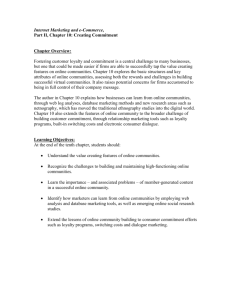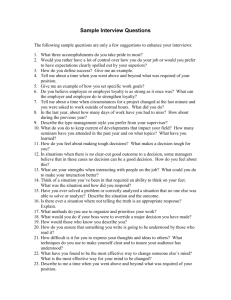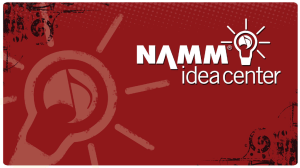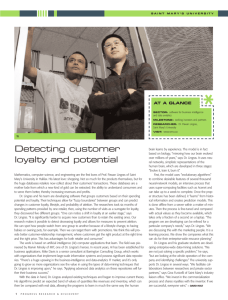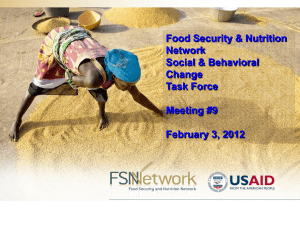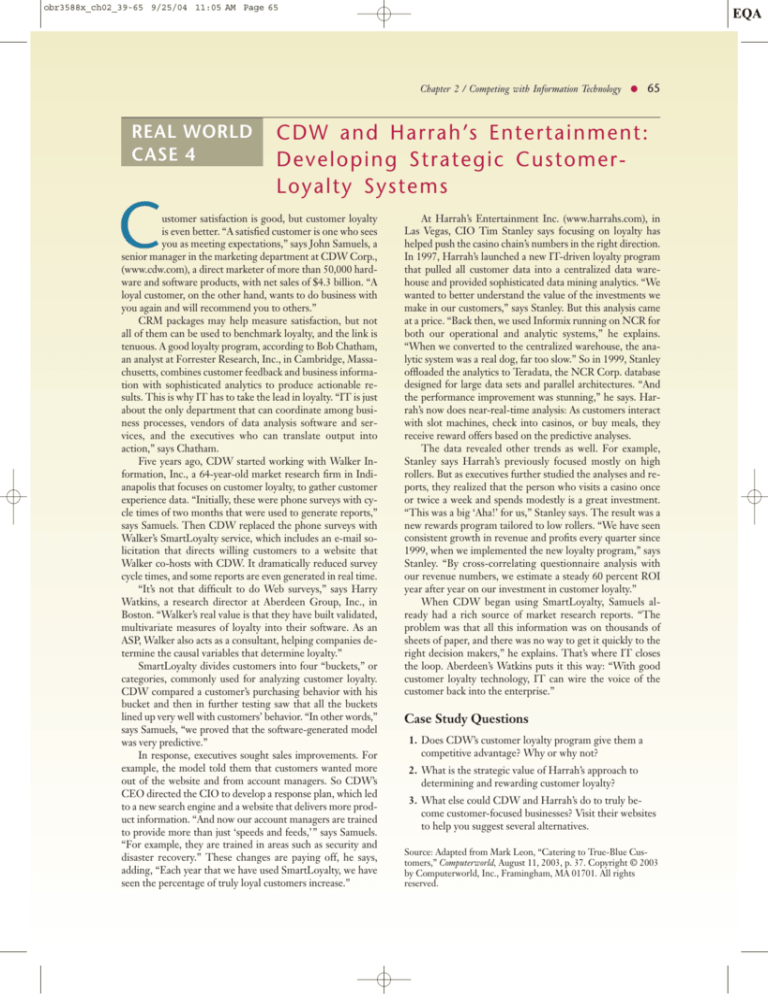
obr3588x_ch02_39-65 9/25/04 11:05 AM Page 65
EQA
Chapter 2 / Competing with Information Technology ● 65
REAL WORLD
CASE 4
C
CDW and Harrah’s Entertainment:
Developing Strategic CustomerLoyalty Systems
ustomer satisfaction is good, but customer loyalty
is even better. “A satisfied customer is one who sees
you as meeting expectations,” says John Samuels, a
senior manager in the marketing department at CDW Corp.,
(www.cdw.com), a direct marketer of more than 50,000 hardware and software products, with net sales of $4.3 billion. “A
loyal customer, on the other hand, wants to do business with
you again and will recommend you to others.”
CRM packages may help measure satisfaction, but not
all of them can be used to benchmark loyalty, and the link is
tenuous. A good loyalty program, according to Bob Chatham,
an analyst at Forrester Research, Inc., in Cambridge, Massachusetts, combines customer feedback and business information with sophisticated analytics to produce actionable results. This is why IT has to take the lead in loyalty. “IT is just
about the only department that can coordinate among business processes, vendors of data analysis software and services, and the executives who can translate output into
action,” says Chatham.
Five years ago, CDW started working with Walker Information, Inc., a 64-year-old market research firm in Indianapolis that focuses on customer loyalty, to gather customer
experience data. “Initially, these were phone surveys with cycle times of two months that were used to generate reports,”
says Samuels. Then CDW replaced the phone surveys with
Walker’s SmartLoyalty service, which includes an e-mail solicitation that directs willing customers to a website that
Walker co-hosts with CDW. It dramatically reduced survey
cycle times, and some reports are even generated in real time.
“It’s not that difficult to do Web surveys,” says Harry
Watkins, a research director at Aberdeen Group, Inc., in
Boston. “Walker’s real value is that they have built validated,
multivariate measures of loyalty into their software. As an
ASP, Walker also acts as a consultant, helping companies determine the causal variables that determine loyalty.”
SmartLoyalty divides customers into four “buckets,” or
categories, commonly used for analyzing customer loyalty.
CDW compared a customer’s purchasing behavior with his
bucket and then in further testing saw that all the buckets
lined up very well with customers’ behavior. “In other words,”
says Samuels, “we proved that the software-generated model
was very predictive.”
In response, executives sought sales improvements. For
example, the model told them that customers wanted more
out of the website and from account managers. So CDW’s
CEO directed the CIO to develop a response plan, which led
to a new search engine and a website that delivers more product information. “And now our account managers are trained
to provide more than just ‘speeds and feeds,’ ” says Samuels.
“For example, they are trained in areas such as security and
disaster recovery.” These changes are paying off, he says,
adding, “Each year that we have used SmartLoyalty, we have
seen the percentage of truly loyal customers increase.”
At Harrah’s Entertainment Inc. (www.harrahs.com), in
Las Vegas, CIO Tim Stanley says focusing on loyalty has
helped push the casino chain’s numbers in the right direction.
In 1997, Harrah’s launched a new IT-driven loyalty program
that pulled all customer data into a centralized data warehouse and provided sophisticated data mining analytics. “We
wanted to better understand the value of the investments we
make in our customers,” says Stanley. But this analysis came
at a price. “Back then, we used Informix running on NCR for
both our operational and analytic systems,” he explains.
“When we converted to the centralized warehouse, the analytic system was a real dog, far too slow.” So in 1999, Stanley
offloaded the analytics to Teradata, the NCR Corp. database
designed for large data sets and parallel architectures. “And
the performance improvement was stunning,” he says. Harrah’s now does near-real-time analysis: As customers interact
with slot machines, check into casinos, or buy meals, they
receive reward offers based on the predictive analyses.
The data revealed other trends as well. For example,
Stanley says Harrah’s previously focused mostly on high
rollers. But as executives further studied the analyses and reports, they realized that the person who visits a casino once
or twice a week and spends modestly is a great investment.
“This was a big ‘Aha!’ for us,” Stanley says. The result was a
new rewards program tailored to low rollers. “We have seen
consistent growth in revenue and profits every quarter since
1999, when we implemented the new loyalty program,” says
Stanley. “By cross-correlating questionnaire analysis with
our revenue numbers, we estimate a steady 60 percent ROI
year after year on our investment in customer loyalty.”
When CDW began using SmartLoyalty, Samuels already had a rich source of market research reports. “The
problem was that all this information was on thousands of
sheets of paper, and there was no way to get it quickly to the
right decision makers,” he explains. That’s where IT closes
the loop. Aberdeen’s Watkins puts it this way: “With good
customer loyalty technology, IT can wire the voice of the
customer back into the enterprise.”
Case Study Questions
1. Does CDW’s customer loyalty program give them a
competitive advantage? Why or why not?
2. What is the strategic value of Harrah’s approach to
determining and rewarding customer loyalty?
3. What else could CDW and Harrah’s do to truly become customer-focused businesses? Visit their websites
to help you suggest several alternatives.
Source: Adapted from Mark Leon, “Catering to True-Blue Customers,” Computerworld, August 11, 2003, p. 37. Copyright © 2003
by Computerworld, Inc., Framingham, MA 01701. All rights
reserved.




